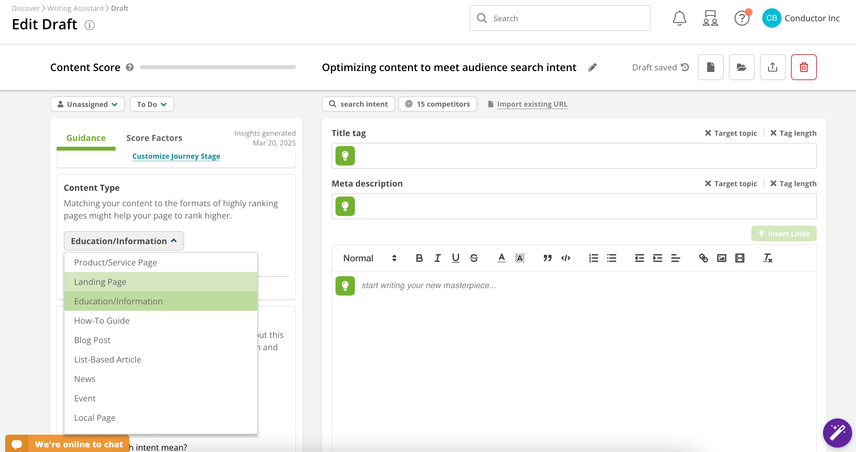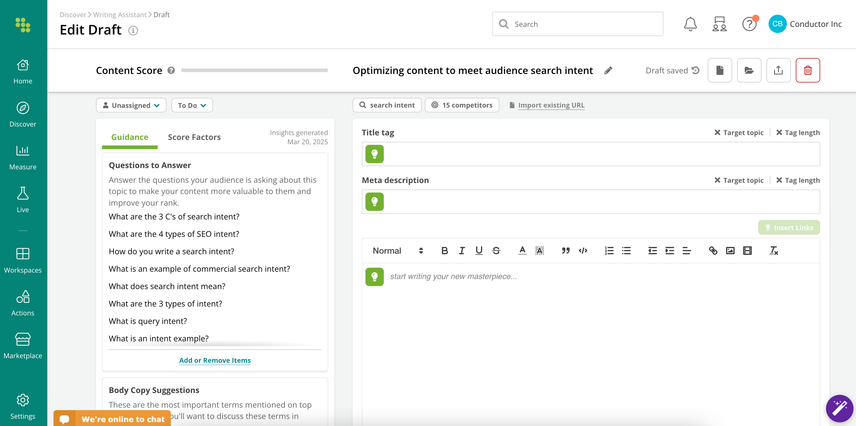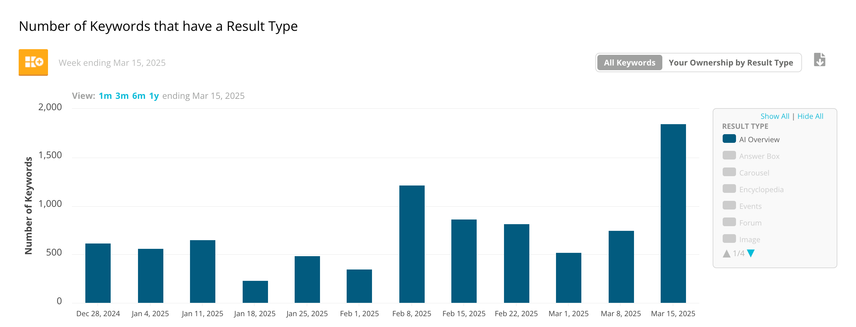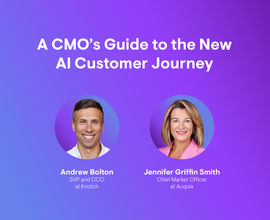How to Optimize Your Site and Content for AI-Powered Search
- Thought Leadership
- By Caroline Wilson
- 6 minutes read
Improve your content's visibility in AI search results with these 10 proven strategies, from E-E-A-T principles to schema markup and beyond.
With the increasing popularity of AI-powered search through tools like Claude , ChatGPT , Perplexity , and even Google’s AI Overviews, the tried and true SEO best practices aren’t yielding the results they used to. Brands need to adapt in order to ensure their content is visible on AI search as well as traditional search.
The good news is that the rules of the game with AI search aren’t too different from SEO. AI-driven search engines prioritize well-structured, authoritative, and relevant content. Whether you're looking to improve visibility in AI Overviews or ensure your expertise is effectively recognized by LLMs, follow these best practices to improve visibility in AI answer engines and ensure your content is effectively recognized by large language models (LLMs).
1. Craft content for AI summarization & readability
AI Overviews prioritize clear, authoritative, and well-structured content that directly answers user queries.
- Write clear, authoritative content: Align with user intent, avoid fluff, and ensure information is easy to summarize.
- Make content skimmable: Use logical organization and a clear hierarchy to make it easier for AI and users to digest.
- Use structured formatting such as:
- FAQ sections for direct answers.
- Bullet points & numbered lists for key takeaways.
- Clear headings & subheadings for logical flow.
- Bold or highlighted text to emphasize important points.
- In Writing Assistant, enter your draft and refine it using AI-driven optimization suggestions.
- Customize the objective, audience, and customer journey to align with what you’re writing for.
- Optimize your content based on Writing Assistant insights.
- Update the Content Type insight card in Writing Assistant to guide content structure.
- Dive into the Header Patterns insight card to craft strong, effective headers.
2. Optimize on-page elements for AI recognition & search visibility
- Use targeted keywords: Incorporate relevant keywords in titles, meta descriptions, headers, and body content.
- Enhance formatting for readability: Structure content with headings, subheadings, and strategic formatting to improve both search visibility and user engagement.
- In Writing Assistant, enter your content and get real-time suggestions on where to place missing or underutilized keywords in your:
- Titles & Headings (to improve AI recognition)
- Body Content (to enhance readability and relevance)
- Meta Descriptions (to boost click-through rates in search results)

3. Optimize for conversational AI & question-based queries
AI-driven search increasingly favors natural, question-based queries and conversational content. Structuring content to align with these trends improves visibility in AI-generated search results and voice searches.
- Write in a conversational tone: Mimic natural speech patterns and structure content in a way that aligns with how users phrase queries in voice and text searches.
- Use Q&A formats: Clearly present questions and answers to match AI-generated search summaries and voice search responses.
- Target long-tail keywords: Capture more specific user intent by incorporating detailed, question-based queries that drive engagement and conversion.
- Incorporate keyword variations: Use alternative phrasings and related terms to maximize discoverability across different AI interpretations.
- Use Writing Assistant & Content Guidance to identify and optimize for frequently searched questions.
- Check the “Questions to Answer” section to find missed opportunities.
- Enter a question in Writing Assistant, highlight it, and use the “Expand Selection” tool to generate ideas for your content.
- Track long-tail or question-based keywords to assess AI Overview positioning and performance.

4. Keep content fresh & updated
- Refresh outdated information: Add new insights, statistics, and trends to improve visibility.
- Ensure accuracy: AI favors up-to-date, well-researched content.
- Use Pages in Conductor to track outdated pages and flag content that needs updates.
- Identify content with declining engagement metrics and prioritize refreshes.
- Set up a Custom Element in Conductor Website Monitoring to pull in pages that haven’t been updated in the past year.
5. Identify relevant keywords & sources
- Analyze credibility signals: Identify which sources LLMs reference to understand ranking patterns and authoritative signals.
- Discover high-value AI keywords: Research the terms and topics frequently appearing in AI Overviews.
- Use Result Types to track where your content appears in AI Overviews.
- Leverage Explorer to discover untracked keywords and analyze which pages are being featured.
- Identify high-ranking competitor pages in AI Overviews and analyze their content strategies.

6. Prioritize E-E-A-T to build AI & user trust
- Demonstrate experience & authority: Use expert insights, first-hand experiences, and credible references to build credibility.
- Enhance transparency: Strengthen authority with author bios and authoritative outbound links.
E-E-A-T matters, and authorship is back: Dive into E-E-A-T's impact and how to maximize your content quality and authority.
7. Implement Schema Markup & structured data
Use structured data (Schema Markup) to help AI better understand your content and improve search visibility. For example:
- FAQ Schema: Helps AI generate instant answers from your content.
- How-To Schema: Guides users through step-by-step instructions.
- Product Schema: Enhances product pages with pricing, reviews, and availability.
- Review Schema: Displays star ratings and reviews directly in search results.
- Ensure structured data is properly configured for improved visibility.
- Use Schema tools like Schema.org Validator , Rich Result Tester , JSON Schema Validator , and Chat GPT to help you create and implement Schema on your website.
- Monitor your schema implementation with Conductor Website Monitoring (CWM) to detect and fix any errors, ensuring your markup remains valid and effective.
8. Enhance content with multimedia resources
- Use High-quality images & infographics: Visuals improve content depth and appeal.
- Optimize accessibility: Add alt text, captions, and transcripts for better AI interpretation.
9. Improve internal linking & contextual relevance
- Strengthen topic connections: Link to related articles to help AI understand content relationships.
- Use descriptive anchor text: Replace vague phrases like “click here” with meaningful keyword-rich links.
10. Monitor AI & search performance metrics
- Monitor AI Overview visibility: Track how often your content appears in AI-generated search results.
- Analyze performance trends: Assess CTR (Click-Through Rate), impressions, and clicks over time.
- In Conductor, track a list of AI Overview keywords for which you have previously appeared (create a Standard Keyword Group of these keywords).
- Under Search Console Analytics, select the AI Overview keywords group to analyze performance.
- Monitor CTR, impressions, and clicks over time to assess how AI-generated results impact engagement.
AI search optimization in review
As AI continues to reshape how users find information online, adapting your content strategy has become essential. Remember that optimizing for AI is fundamentally about creating high-quality, well-structured content that genuinely answers user questions and provides value. By focusing on clarity, authority, and technical optimization, you can position your content to perform well not just in traditional search results but also in AI Overviews and other AI-generated responses.
Start implementing these strategies today, with the help of platforms like Conductor, to track your progress and refine your approach.







